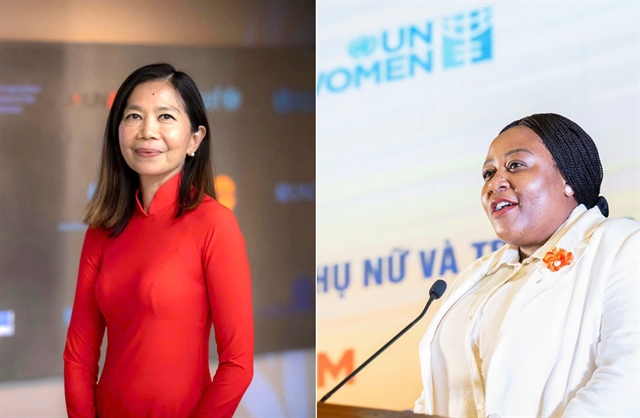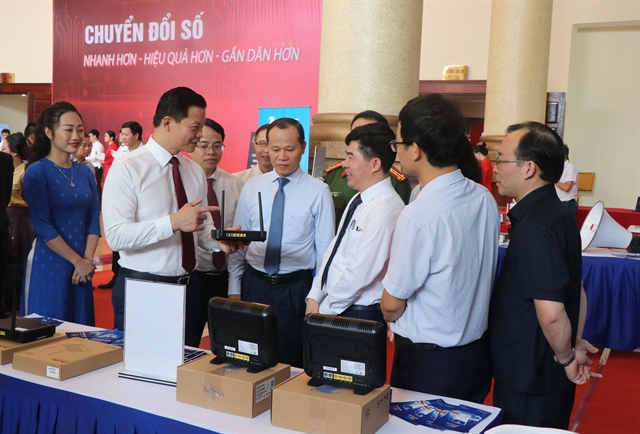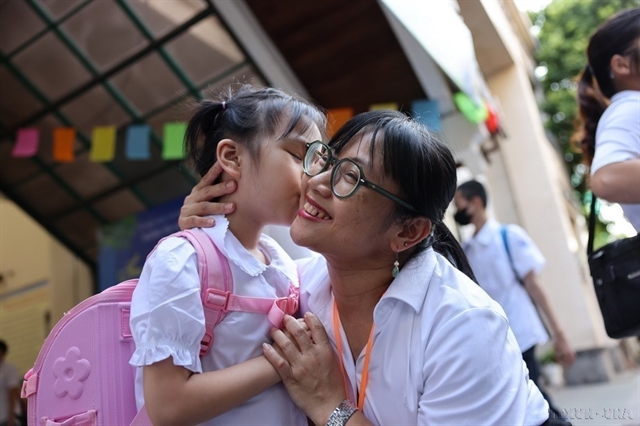 Op-Ed
Op-Ed


|
| A teacher welcomes her student at the Binh Minh Primary School in Hoàn Kiếm District, Hà Nội. — VNA/VNS Photo |
HÀ NỘI — Placing people at the centre and considering people as the objective, subject and driving force of national development, with the State respecting, guaranteeing and protecting human rights and citizens’ rights, are a major principle outlined in the 13th Party Central Committee's Resolution No. 27-NQ/TW dated November 9, 2022, on continuing to build and perfect the socialist rule-of-law State of Việt Nam in the new era.
This principle – putting people at the heart of development – is not merely an aspirational goal but is being systematically implemented in Việt Nam.
Discussing human rights, in his book “Some theoretical and practical issues on socialism and the path towards socialism in Việt Nam,” when he was alive, Party General Secretary Nguyễn Phú Trọng emphasised: “We should not wait until the economy reaches a high level of development to realise social progress and justice, nor should we ‘sacrifice’ social progress and justice in pursuit of mere economic growth.”
Caring for the material and spiritual life of the people – such as poverty reduction, access to education and healthcare services – is a concrete expression of the policy of placing people at the core and as the subject of socio-economic development.
Việt Nam has issued eight iterations of poverty standards, each time raising the basic needs threshold: 1993–1995; 1995–1997; 1997–2000; 2001–2005; 2006–2010; 2011–2015; 2016–2020; and 2021–2025.
Under the 1993–1995 standards, hungry households had a per capita monthly income (converted to rice) of less than 13kg in urban areas and less than 8kg in rural areas, while poor households had a per capita monthly income below 20kg in urban areas and 15kg in rural areas.
From 2001–2005, the term “hungry household” was no longer used. Instead, “poor household” was defined by income: 80,000 VND (3.08 USD following current exchange rate)/person/month in mountainous and island rural areas; 100,000 VND/person/month in lowland rural areas; and 150,000 VND/person/month in urban areas.
From 2016–2020, Việt Nam adopted the “multidimensional poverty standard”, which included criteria on income and basic service access (health care, education, housing, clean water and sanitation and information). It defined poor, near-poor and average-income households.
In the 2021–2025 period, the multidimensional poverty standard set income thresholds at VNĐ1.5 million/person/month in rural areas and VNĐ2 million/person/month in urban areas.
In 1993, 58.1 per cent of Vietnamese households were considered poor. By 2015, the rate fell to 9.88 per cent, and by 2024, the figure was just 1.93 per cent, or about 600,000 households according to the new multidimensional poverty standards. The combined rate of poor and near-poor households in 2024 was 4.06 per cent (over 1.2 million households), a decrease of 1.65 per cent compared to 2023.
HCM City and Bà Rịa-Vũng Tàu Province reported a 0 per cent multidimensional poverty rate (including both poor and near-poor households). Hà Nội, Hải Phòng, Quảng Ninh, and Bắc Ninh no longer had any households classified as poor.
Việt Nam is the first country in Asia to adopt the multidimensional poverty standards and is among the world's top 30 in this regard.
According to the Global Multidimensional Poverty Index (MPI) report released on July 15, 2023, by the United Nations Development Programme (UNDP) and the Oxford Poverty and Human Development Initiative (OPHI), Việt Nam was one of 25 countries to have halved its MPI within 15 years.
Alongside poverty reduction, Việt Nam has also achieved strong growth in gross domestic product (GDP) and per capita GDP.
In 1974, the combined economy of North and South Việt Nam was less than $22 billion. From 1976–1980, GDP growth averaged only 1.4 per cent; in 1980, it was negative (-1 per cent). By 2024, Việt Nam's GDP had reached $476.3 billion –nearly 129 times that of 1975 – and ranked 24th globally in terms of Purchasing Power Parity (PPP). According to IMF forecasts, the Vietnamese economy is projected to reach $506 billion in 2025.
In 1989, per capita income was just $96. By 2009, Việt Nam had reached lower-middle-income status with $1,120 per capita. In 2024, per capita GDP was $4,700 (around VNĐ114 million), 58.75 times higher than in 1975.
Rising income levels have also coincided with increased life expectancy. The average life expectancy of Vietnamese people rose from about 38 in 1945 to 60 during 1975–1980, and to 74.5 today.
Việt Nam currently has nearly 432,000 healthcare personnel, equating to 14 doctors per 10,000 people, and a network of 1,645 hospitals, including 34 central-level and nearly 500 provincial-level hospitals. The country is aiming to exempt hospital fees for all people.
According to the Ministry of Health, by 2026–2030, 90 per cent of the population is expected to have full access to disease prevention and health promotion services. Every citizen will receive an annual health check-up. By 2035 or 2045, Việt Nam's healthcare system aims to fully and promptly meet the population’s needs in terms of healthcare, ensuring that people pay no additional costs for health services covered by insurance.
Việt Nam also plans to offer free education to all students, from nursery (from three months old) through to the end of public upper secondary school (over 22 million students), starting from the 2025–2026 academic year. Non-public school students (over 1 million) will be subsidised from the State budget with an amount equivalent to public school tuition fees.
Việt Nam's education expenditure from the State budget accounts for approximately 4.9 per cent of GDP. By 2017, the country had achieved universal preschool education for five-year-old children. Today, all 63 provinces and cities have achieved 100 per cent coverage of universal primary education standards.
The United Nations has recognised and highly praised these achievements, which result from a people-centred development approach.
According to the Human Development Report (HDR) 2025 released by UNDP in Việt Nam on May 12, 2025, Việt Nam's Human Development Index (HDI) in 2023 reached 0.766, placing it among countries with high human development, ranking 93rd out of 193 countries and territories. From 1990 to 2023, Việt Nam's HDI rose from 0.499 to 0.766, an increase of 53.5 per cent.
The Human Development Report has been published almost annually since 1990. The HDI is a comparative index measuring income, literacy, life expectancy and other human development factors across countries.
The key characteristics of the human development approach include placing people at the centre of development; identifying people as the goal of development; enhancing people’s status (in both enjoyment and contribution); promoting equality for all regardless of religion, ethnicity, gender, nationality, or skin colour; and enabling optimal choices for citizens in economic, political, social and cultural domains.
The HDI measures a nation’s average achievement in three basic dimensions of human development: Health (LEI) - a long and healthy life measured by life expectancy; Education (EI) – measured by mean years of schooling (MYSI) and expected years of schooling (EYSI); and Income – measured by Gross National Income (GNI) per capita.
Speaking at the High-Level General Debate of the 79th Session of the United Nations General Assembly on September 24, 2024, under the theme “leaving no one behind: acting in solidarity to promote peace, sustainable development, and human dignity for present and future generations”, General Secretary of the Communist Party of Việt Nam Central Committee Tô Lâm, who was then also the President of Việt Nam, shared Việt Nam's vision for a peaceful, stable, cooperative, prosperous, and sustainable future for all.
The leader emphasised: “People are placed at the centre as the main subject in order to realise visions. People are considered the centre, the objective, and the driving force of all policies and actions at all levels.” — VNA/VNS